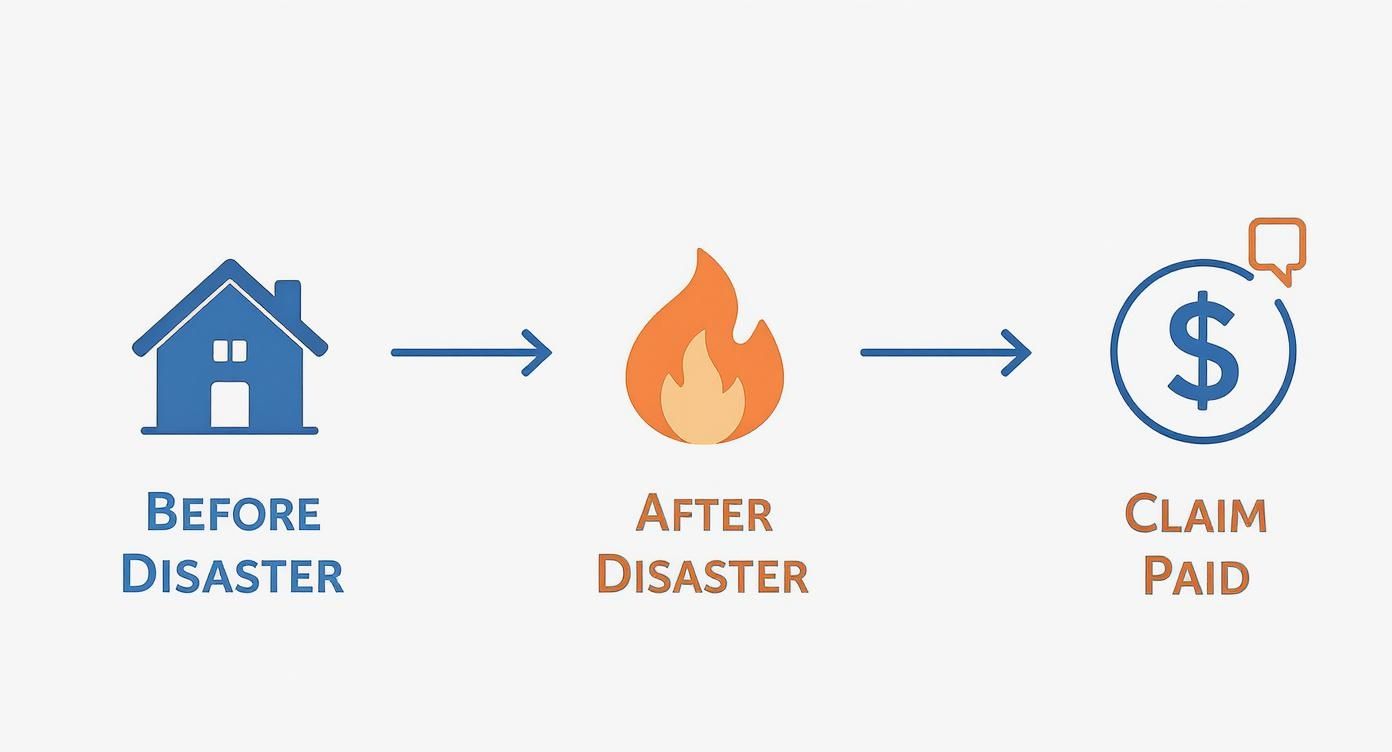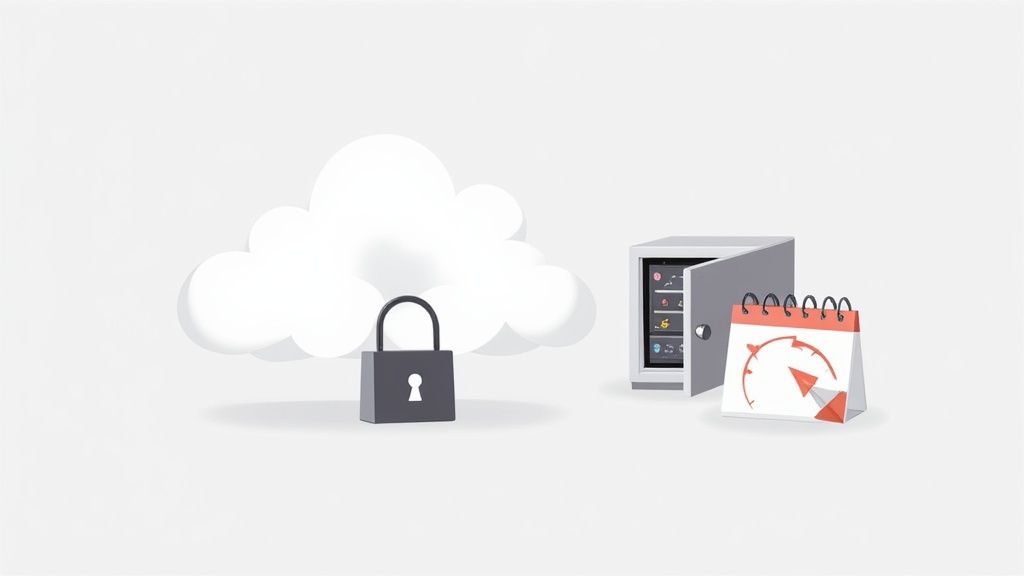A home inventory for insurance is more than just a list of your stuff. Think of it as your single most powerful tool for getting your life back on track after a disaster like a fire, theft, or flood. It’s a detailed record of your personal possessions, complete with their estimated value and proof of ownership, designed to speed up your claim and ensure you get paid what you're owed.
Why a Home Inventory Is Your Best Insurance Policy
Picture the absolute chaos after a major loss, like a house fire. You're emotionally drained, displaced, and trying to figure out what comes next. Then, your insurance company asks for a complete list of every single item that was damaged or destroyed.
Without a home inventory, you're left trying to recall everything from memory. The brand of your TV? The number of forks in the kitchen drawer? The contents of your closet? It's an impossible task under the best of circumstances, let alone during a crisis.
A prepared inventory turns that nightmare scenario into a manageable, step-by-step process. It’s a clear, undeniable record that removes the guesswork and helps you avoid frustrating disputes with your insurer.
The Financial Safety Net You Create Yourself
When you file an insurance claim, the burden of proof is on you. It's your responsibility to show what you owned and what it was worth. The insurance adjuster's job is to verify your losses, and without solid evidence, they might undervalue or even deny parts of your claim.
A comprehensive home inventory for insurance is the concrete proof you need to get the full value you're entitled to under your policy. It substantiates your claim for everything, from the big-ticket items down to the smaller things that add up fast, like:
- Kitchenware: That high-end cookware set, the fancy espresso machine, and all your dishes.
- Clothing and Accessories: Designer bags, custom suits, or an extensive shoe collection.
- Tools and Hobby Gear: Your full set of power tools, prized musical instruments, or expensive sporting equipment.
Your home inventory is your personal insurance policy for your insurance policy. It's the evidence that guarantees you won't have to settle for less than you deserve when you're at your most vulnerable.
Overcoming a Common (and Costly) Oversight
For something so crucial, it's shocking how many people skip this step. A Farmers Insurance study found that nearly 50% of U.S. residents don't have a home inventory. That’s a huge gamble.
This oversight can lead to significant financial loss and heaps of unnecessary stress when disaster strikes. It makes verifying the existence and value of your possessions incredibly difficult for both you and your insurer. You can see all the details in the full study on home inventory preparedness.
Creating an inventory is one of the most proactive things you can do to protect your finances. It's a small investment of your time that safeguards the value of everything you've worked so hard to acquire, giving you priceless peace of mind.
How to Document Everything You Own, Room by Room
Staring down the task of creating a home inventory for insurance feels like trying to boil the ocean. It’s overwhelming. But here’s the secret I’ve learned from years of experience: don’t try to tackle the whole house at once. The goal is to build momentum, turning a monster project into a series of small, satisfying wins.
Just pick one room. Any room. Even starting with a single junk drawer can get the ball rolling and prove you can do this. The room-by-room approach breaks the whole process into bite-sized chunks, making it far less intimidating and way more likely you'll actually finish.
Start Small to Win Big
Your first move is simply choosing a starting point. I always tell people to start with the easiest space, like a small bathroom, a guest closet, or maybe the laundry room. Why? Because you can knock it out fast. Finishing one small area gives you a shot of accomplishment that fuels you to keep going.
From there, you can graduate to the more cluttered spaces like the kitchen or garage. The key is to be methodical. Carve out an hour or two on the weekend, put on some music, and focus on one space at a time. Before you know it, you'll have a complete, claim-ready record of your possessions.
A complete home inventory isn't built in a single afternoon. It's assembled one room, one closet, and one drawer at a time. The most important step is the first one, no matter how small.
Think of it this way: the effort you put in now is a direct investment in your peace of mind later. When disaster strikes, you won't be scrambling; you'll be prepared.

This simple flow chart says it all. Preparation before a disaster is the most direct path to a fast, fair, and successful claim payment afterward.
Your Phone Is Your Most Powerful Tool
The camera in your pocket is all you need to create an incredibly effective inventory. Forget writing everything down on a legal pad. Use a combination of video and photos to capture everything quickly and accurately.
Here’s a simple but powerful technique I use:
- Start with a panoramic video. Stand in the doorway of the room and slowly pan your phone from left to right. As you record, narrate what you’re seeing. Say the big-ticket items out loud, like "Samsung 65-inch Frame TV" or "West Elm leather sectional sofa." This creates a great overview.
- Open everything. As you continue your video tour, open every single closet, cabinet, and drawer. Sweep your camera over the contents slowly. This is a brilliant shortcut for capturing groups of items, for instance, your entire collection of dishes, all the clothes in a closet, or every tool in a drawer, in just seconds.
- Photograph the valuables. After your video sweep, go back and take clear, individual photos of your most significant items. We're talking electronics, appliances, furniture, artwork, jewelry, and anything else you’d hate to lose.
This one-two punch of a broad video overview and specific photos gives your insurance adjuster undeniable proof of what you owned. For a complete list of what to capture room by room, you can check out this detailed home inventory checklist.
What to Record for Each Item
A photo is worth a thousand words, but a few key details will make it priceless during a claim. You don't need to write a novel for each item, just enough information to prove its existence and value.
For each major item, try to capture these details:
- Brand and Model: This is critical for electronics and appliances (e.g., Sony PlayStation 5, KitchenAid Stand Mixer KSM150PSER).
- Serial Number: Use your phone to take a close-up photo of the serial number on your TV, computer, power tools, or any other high-value gear. It’s the ultimate proof of ownership.
- Purchase Date and Price: If you have the receipt, snap a picture of it. If not, don't sweat it; a reasonable estimate is fine. You can usually find the original price by searching the model number online.
- A Brief Description: Make a quick note about its condition or any unique features. Something like, "Antique oak rocking chair, inherited from grandmother, excellent condition," is perfect.
Uncovering Commonly Overlooked Items
It’s easy to remember the big stuff like your couch and your TV. But insurance claims often get held up by the hundreds of smaller items that can add up to thousands of dollars in replacement costs. As you go through each room, keep an eye out for these easily forgotten categories.
| Room | Commonly Overlooked Items | Why They Matter |
|---|---|---|
| Kitchen | Small appliances (air fryer, blender), quality cookware, knife sets, silverware, and fine china. | Replacing an entire kitchen's worth of tools and gadgets is shockingly expensive. A good set of pots and pans alone can run you hundreds. |
| Living Room | Books, movies, video games, rugs, lamps, curtains, and decorative items. | While individually inexpensive, the collective value of your media collection and home decor can be massive. |
| Home Office | External hard drives, monitors, printers, ergonomic chairs, and specialized software. | Your home office contains much more than just a computer. All that supporting equipment adds up to a substantial replacement cost. |
| Garage/Shed | Power tools, lawn mowers, sporting goods (bikes, skis), and camping gear. | These areas often store some of your priciest possessions, which also happen to be common targets for theft. |
Gathering Proof of Value for Your Insurance Claim
A detailed list of your possessions is a great start, but when it comes time to file a claim, your insurance company needs more. They need cold, hard proof of value. This is where your inventory transforms from a simple checklist into the backbone of your claim.
It’s all about gathering the evidence that confirms what you owned and what it was worth. This means digging up receipts, warranties, and for your most prized possessions, getting formal appraisals. It sounds like a chore, I know, but these documents are what stand between a fast, fair payout and a frustrating, drawn-out negotiation.

Unearthing Your Proof of Purchase
Your mission is to find any document that attaches a dollar figure to an item. The more official the proof, the less room your insurer has to argue. To make this easier on yourself, consider using dedicated receipt organizer apps which can be a lifesaver for tracking down what you spent and when.
Here’s what you should be hunting for:
- Digital and Physical Receipts: Your email inbox is a goldmine. Search for terms like "receipt," "order confirmation," or the names of stores you frequent. For paper receipts, snap a clear photo and link it directly to the item in your digital inventory.
- Warranties and Manuals: These are surprisingly useful. They almost always include the model number, purchase date, and other details that establish an item’s identity and age.
- Bank or Credit Card Statements: Can't find the receipt? A bank statement showing the transaction is the next best thing. It’s solid proof of the purchase date and the amount you paid.
I once helped a friend after a break-in. His high-end laptop was gone, and the insurance company was about to pay out a generic, depreciated value. But he remembered he'd taken a single photo of the serial number on the bottom of the device. That one photo proved it was a premium model, and it literally saved him hundreds of dollars on his claim. Little details matter.
Appraisals for Your High-Value Items
Some of your most precious belongings, like jewelry, art, and antiques, need more than just a receipt. A standard proof of purchase just doesn't capture their true worth, especially if their value has appreciated over time.
A professional appraisal is an official valuation from a certified expert. It’s non-negotiable proof of an item’s value. You absolutely need one for things like:
- Fine jewelry and engagement rings
- Artwork and sculptures
- Antiques and family heirlooms
- Rare collectibles (like stamps, coins, or first-edition books)
Always get a digital copy of every appraisal and link it directly to the item in your inventory. This is the kind of documentation an insurer simply can’t dispute. As we cover in our guide, a solid photo inventory strengthens insurance claims immeasurably, and pairing those photos with appraisals is a winning combination.
Understanding Your Insurance Policy Coverage
The documents you collect are directly tied to the type of coverage you have. Your homeowners or renters policy will offer one of two types of personal property coverage, and the difference between them is massive.
- Actual Cash Value (ACV): This coverage pays you what an item was worth the moment it was lost. It’s the original price minus depreciation. So, that five-year-old TV you loved? Its ACV will be much lower than what you paid for it.
- Replacement Cost Value (RCV): This is the one you want. RCV pays you the full amount needed to buy a new, similar item at today's prices, with no deduction for depreciation. Yes, RCV policies cost a bit more, but they offer vastly better financial protection.
No matter which policy you have, a detailed inventory is your greatest asset. For an ACV policy, your documentation helps establish the item's original cost and condition, leading to a more favorable depreciation assessment. For an RCV policy, your inventory proves you owned an item of a certain quality, ensuring you get the funds to replace it with something of equal value, not a cheaper alternative.
Ultimately, your inventory gives you the leverage to get the maximum payout you’re entitled to.
Using Digital Tools to Create Your Inventory
Let's be honest, the old-school approach of building a home inventory for insurance with a spreadsheet and a camera is a slog. It’s tedious, slow, and it’s incredibly easy to let it fall by the wayside. Thankfully, we don't have to do it that way anymore. Technology, especially dedicated apps, can turn this monumental chore into a surprisingly manageable project.
These aren't just fancy list-makers. The right digital tool helps you build a detailed, claim-ready database of everything you own. It takes advantage of that powerful computer in your pocket, your smartphone, to make documenting faster, more accurate, and a whole lot more organized than any manual method ever could be.
Leaning on Smart Features for a Better Inventory
The real magic of using a dedicated app lies in its smart features and automation. Modern inventory apps use your phone's camera for a lot more than just snapping a few pictures. Many can recognize items, suggest categories, and even help you find an item's estimated value online with a quick search.
This kind of automation is a total game-changer. It cuts down on the mind-numbing data entry, freeing you up to focus on capturing the details that really matter.
Here are a few key features you should absolutely look for:
- Receipt Scanning: Instantly capture and link a digital copy of a receipt to an item. This simple action means you'll never have to dig through a shoebox of faded receipts to prove what you paid.
- Secure Cloud Backup: Your inventory is automatically saved to a secure online server. This is critical; it ensures your list survives the very disaster you're preparing for, whether it's a fire, flood, or theft that takes your computer with it.
- Easy Sharing: When you need it most, you can securely share a complete, professional-looking report with your insurance agent in just a few clicks. This can dramatically speed up the claims process.
The point of a digital tool isn’t just to make another list. It’s to create a living, searchable, and easily verifiable record of your belongings that will stand up to the scrutiny of an insurance adjuster.
If you want to dig deeper into what separates the good apps from the great ones, check out our guide on choosing the best home inventory software for a full breakdown of the must-have features.
A Real-World Example: The Home Entertainment System
Let's walk through a practical example: documenting a home entertainment system. A typical setup has a lot of moving parts, including a TV, a soundbar, a gaming console, a streaming device, and a handful of controllers.
Using a spreadsheet, you'd be creating a new row for each component, manually typing in the brand, model, and serial number for every single piece. Then you'd have to figure out a system to name your photo files and somehow link them back to the right row. It’s clunky, disconnected, and just begging for errors.
Here is what an intuitive app interface might look like when you're organizing your items.
The visual layout helps you quickly see and manage items without getting lost in endless rows of text.
Now, contrast that with the workflow in a dedicated app:
- Create a "Container" First, you'd create a group and name it "Living Room Entertainment Center." This keeps everything neatly bundled.
- Add the TV: Snap a photo of your TV. The app might even use image recognition to suggest "Samsung 65-inch TV." You follow up with a quick photo of the serial number on the back.
- Scan Receipts: Use the app's camera to scan the email receipt for your soundbar. It can automatically pull the purchase date and price, linking it directly to the soundbar's entry.
- Group Accessories: Add the gaming console and all its controllers, linking them within that same "Entertainment Center" group.
The whole process is faster, and the final record is infinitely more organized. You're left with a single, consolidated entry that contains all the components, photos, and proofs of purchase, all ready to be exported for your insurance provider.
Valuing Collectibles and Unique Items
Digital tools also take a lot of the headache out of valuing unique items like antiques, art, or collectibles. While an app can't give you a certified appraisal, it acts as the perfect central hub for organizing the valuation info you gather.
For instance, you can link directly to online sales listings for similar items to help establish a current market value. To get a more official valuation, you can use various online antique appraisal services to get expert opinions without leaving your home.
Once you have a digital report from an appraiser, you can attach it directly to the item's entry in your app. This creates a powerful, self-contained package of evidence that will make your insurance claim much stronger.
You’ve done the hard part. The hours of photographing, documenting, and valuing your belongings are behind you. But a perfect home inventory is completely worthless if it goes up in the same smoke as your house.
Think about it for a second. If a fire or flood wiped out your home tomorrow, taking your laptop and phone with it, could you still get your hands on that inventory? If the answer is no, you’ve got one more critical job to do.
Protecting your documentation is just as important as creating it.

Finding a Safe Place for Your Records
The best storage solutions are both bomb-proof and easy to access when you're under stress. In the aftermath of a disaster, the last thing you want is another hurdle. That’s why digital storage is usually the most practical choice. You can pull up your files from any device with an internet connection, anywhere in the world.
Here are the most reliable options for safeguarding your hard work:
- Cloud Storage Services: Platforms like Google Drive, Dropbox, or iCloud are perfect for this. Just create a dedicated folder for your inventory and dump everything in there: all your photos, videos, spreadsheets, and scanned receipts. Simple and effective.
- App-Based Cloud Backup: If you used a dedicated app like Vorby to build your inventory, this is a no-brainer. Your data is automatically and securely backed up to the cloud. You don’t have to think about it; it’s just done.
- Physical Off-Site Storage: For those who prefer having a tangible backup, grabbing an encrypted USB drive or an external hard drive is a solid move. But the key here is that you must store it off-site. Give it to a trusted family member or put it in a safe deposit box. Keeping it in your desk drawer defeats the entire purpose.
Establishing a Simple Maintenance Routine
A home inventory isn't a "set it and forget it" project. It’s a living document that needs to grow and change along with your life. If it’s not up-to-date, it won't be nearly as useful when you need it most for insurance.
The key is to build a simple, manageable update schedule. You don't need to redo the whole thing every year. That's a recipe for burnout. Instead, the trick is to add new things as you get them and do a quick spot-check every so often.
Your inventory should evolve with your life. A quick 15-minute update after a birthday or holiday can add thousands of dollars in newly acquired assets to your records, making sure every last gift is protected.
To keep your inventory fresh without it feeling like a chore, create "triggers" for updates. Make it a habit to add any significant new purchase to your list the day you get it home. It takes five minutes and saves hours of headaches later.
This proactive approach is more important than ever. The global home insurance market, valued at USD 269.92 billion in 2024, is projected to hit USD 628.52 billion by 2034. As coverage costs climb, having a precise, current inventory is your best defense for justifying your policy limits and shutting down any potential claim disputes. You can learn more about the home insurance market trends on metastatinsight.com.
When to Update Your Home Inventory
Knowing when to update is half the battle. Instead of just picking a random date on the calendar, it’s much more effective to tie your updates to specific life events.
Here’s a practical schedule that actually works:
- After Major Purchases: Just bought a new 4K TV, laptop, or that fancy stand mixer you’ve been eyeing? Before you even throw out the box, take five minutes to add it to your inventory. Snap a picture of the item and its serial number, and upload the receipt. Done.
- Following Holidays or Birthdays: Gifts are just new possessions you didn't pay for. After a big gift-giving event, do a quick sweep to add any new electronics, jewelry, or other valuable items to your list.
- During Spring Cleaning: As you're already going through closets and decluttering, use that momentum to review a room or two. It’s the perfect time to remove items you've sold or donated and confirm your records for that space are still accurate.
- Annually with Your Insurance Renewal: This is the big one. At least once a year, when you get that policy renewal notice in the mail, pull up your inventory. Do a quick scan to make sure the total value still aligns with your coverage amount. This is your annual check-up to ensure you’re not underinsured.
Common Questions About Home Inventories
Even with the best plan, a few questions always pop up when you start creating a home inventory for insurance. That's completely normal. Let's tackle the practical, real-world concerns that come up once you get started.
Getting these answers now will help you sidestep any roadblocks and make sure the time you invest results in an inventory that actually works when you need it.
How Much Detail Is Enough for an Insurance Company?
This is the big one, and for good reason. You want to be thorough, but you don't want to get lost in the weeds documenting every single fork. The secret is matching the level of detail to the item's value.
For most of your day-to-day stuff, keep it simple. A clear photo, the brand and model, and a ballpark guess for the purchase date and price are usually all an adjuster needs. They don't need the serial number for your coffee maker.
But for high-value items, and the industry benchmark for that is generally anything over $1,500, the game changes. You need to bring more proof to the table.
- Jewelry and Artwork: Don't just snap a picture. Get professional appraisals and take detailed, close-up photos.
- Electronics and Appliances: Always, always capture the serial number. Grab a photo of the receipt if you have it and note the exact model number.
- Designer Goods and Collectibles: Your photos should highlight authenticity marks, logos, or any unique features that prove what it is.
The goal here is simple: provide enough evidence to erase any doubt about what an item was and what it was worth. Put yourself in the adjuster's shoes. What would you need to see to confidently approve a claim for its full value? Aim for that.
What if I Have No Receipts for Older Items?
First off, don't panic. This is incredibly common, and insurance companies get it. While receipts are the gold standard, they are far from the only form of proof. Your inventory, especially with its photos and videos, is your single most powerful tool here.
A detailed description, clear photos from a few different angles, and any other scraps of documentation you can find, like the original box, the user manual, or a warranty card, all work together to establish your ownership and the item's condition.
A photo of an item sitting in your living room, taken months before a disaster, is compelling evidence. It proves you owned it and shows its condition, which is often more than enough to substantiate that part of a claim, receipt or not.
For those truly expensive pieces where a receipt is a distant memory, like an antique dresser you inherited, a professional appraisal is your best move. That formal valuation is a document insurers take very seriously.
How Long Does a Home Inventory Take?
The time commitment is what stops a lot of people from even starting, but I promise it’s probably less than you think. Of course, it depends on the size of your home and how much you own, but you can knock out a typical three-bedroom house in a single weekend.
The trick is to not treat it like a marathon. Break the project down.
- Tackle it room by room. Set aside just 1-2 hours for each space. This keeps you focused and prevents that feeling of being totally overwhelmed.
- Use a dedicated app. This is a game-changer. Tools like Vorby can slash your time investment with features like receipt scanning and automatic photo organization. It's worlds faster than fumbling with a spreadsheet.
- Start with an easy win. Do the guest bathroom or a small office first. Finishing a room quickly gives you a shot of motivation to keep going.
The few hours you spend now are a tiny price to pay for the peace of mind you get in return. It could save you weeks of agony and thousands of dollars down the road. This is more critical than ever, as insurance costs are skyrocketing. U.S. homeowners' insurance rates have jumped an average of 48% in the past five years, and people filed 18% more claims in 2023 than in 2019. An inventory helps you get your claim filed accurately and quickly in a tough environment. You can find more details on these rising home insurance statistics on valuepenguin.com.
Should I Inventory My Garage and Shed?
Yes. Absolutely. One hundred percent. This isn't even a question.
Your standard homeowners policy almost always covers personal property in other structures on your land, like detached garages, sheds, and workshops. And these spaces are often packed with high-value items we completely forget about.
Forgetting to document these areas is one of the biggest and most expensive mistakes you can make.
Just think about what's probably out there right now:
- Lawn and Garden Gear: That riding mower, snow blower, and all the trimmers add up fast.
- Tools: A solid collection of power tools and hand tools can easily be worth thousands.
- Sporting Goods: Bikes, golf clubs, skis, kayaks, camping equipment... it's a long list.
- Stored Items: Patio furniture, extra appliances, and all those holiday decorations are expensive to replace from scratch.
These things aren't just valuable; they're also prime targets for theft. Do yourself a favor: take 30 minutes, walk through your garage and shed with your phone, and document all the major equipment. It's a critical final step to a complete inventory.



